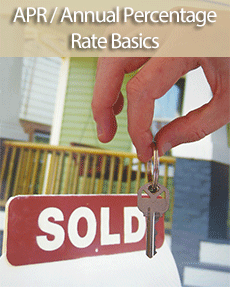 What is APR? It stands for Annual Percentage Rate, but what does that mean? You will see the term on every quotation for finance or credit cards you receive. It is one of those ubiquitous terms that very few people actually understand. What confuses many is the APR is generally higher than the note rate stated on the same quotation!
What is APR? It stands for Annual Percentage Rate, but what does that mean? You will see the term on every quotation for finance or credit cards you receive. It is one of those ubiquitous terms that very few people actually understand. What confuses many is the APR is generally higher than the note rate stated on the same quotation!
This confusing term has been designed by the government to enable you to compare the cost of various financial products irrespective of other variables. The annual percentage rate is not actually the interest rate you will pay over a year. It is a completely artificial term that has been calculated using a complicated formula.
The calculation of the APR, and the need to disclose it, is regulated in the USA by the Truth In Lending Act (aka Regulation Z,) and must be disclosed along with an amortization schedule within three days of an application being made for a mortgage.
What is APR and How to Use It
If the only difference between loans was the APR, then the cheapest loan would be one with the lowest annual percentage rate. The problem is that this is not the only difference between different loans. A mortgage might include set-up fees, discount points and home owner’s insurance to mention just three of many possible additional costs.
The result is that it is very difficult for ordinary people to compare different loans, credit cards or mortgages. Another potential problem is the question of one-off charges applied when a loan is offered. The APR calculation can assume that this payment is spread over a number of years rather than calculate an APR for year #1 then another APR for all succeeding years.
A major problem with the annual percentage rate is that it is time dependant, and individual rates are meaningless unless quoted for the same time period. The APR for a 15 year mortgage cannot be compared to that for a 30 year mortgage. The differences you see are not the true cost of differences between taking a mortgage for 15 and 30 years.
Is The Annual Percentage Rate Pointless?
Another issue is that most online APR calculators assume that a loan will be retained until the full term has run. If you sell your home during the 30 year period, the APR quoted becomes meaningless. The actual interest will then be higher than that quoted. Is the APR in these circumstances pointless?
Not quite. You can still use it to compare the same mortgages offered by different lenders over the same time period, as long as you understand that it applies only if the same fees, interest rates and other charges are the same for each mortgage being compared. It will be of little use in comparing different mortgage products offered by the same or different lenders.
So many people misunderstand its use that it has become a confusing term useful in part only to those that do not sell their home until the mortgage has been fully paid up over the agreed time period. It has limited use in comparing mortgage products, but is the only genuine way to carry out such a comparison.
So What is APR?
What is APR then? It is a synthetic figure derived by taking all costs involved in a particular mortgage product into consideration and calculating an average annual percentage rate over the entire period of the mortgage loan. It becomes invalid when charges vary and if the borrower sells the property before the mortgage has been paid up over the original period (e.g. 15 or 30 years.) However, it does enable some degree of comparison to be made between similar mortgage products.


About The Author: Karengustin
More posts by karengustin